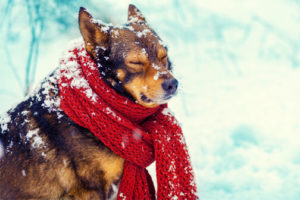Before fall turns to winter, it’s smart to winterize your home and car to ensure they’re ready for the seasonal changes ahead, but what about your dog? Here are five important tips to consider to help you “winterize” your dog.
1) Don’t Skimp on Bug Control

In the colder months, we humans get a major vacation from biting insects, depending on where we live. Many people assume the same thing goes for dogs, too, but that assumption would be dangerously false. Ticks can survive well into the winter, especially in an unseasonably warm winter. Plus, when it does begin to get cold, some ticks are known to surge, becoming more desperate for a last blood meal before they go dormant. Ticks can be as bad in autumn as they are in spring, if not worse, so it is incredibly important to maintain your dog’s flea and tick preventative year-round, preferably one that doesn’t use toxic pesticides.
2) Stay Ahead of the Shed

Depending on the breed of dog, you may notice an increase in the amount your dog sheds in the winter. The simple reality is that when dogs spend more time indoors, they’re going to leave more fur all over your house. There’s no getting around some extra vacuuming and sweeping of fur, but you can remove a lot of it beforehand by being more proactive with your dog’s bathing and grooming. Nutrition also plays a major role in excessive shedding so consider adding a supplement such as Skin & Coat Oil to help achieve a soft, shiny, and healthy coat, while addressing itchy dog skin this winter.
3) Lube Up Those Old Bones

Just like people, older dogs may have a harder time adjusting to colder temperatures, particularly those that may predisposed to hip or other joint issues. A daily joint supplement can help keep those joints lubricated to keep your dog active and comfortable in the winter months.
4) Prepare for Holiday Gatherings

Autumn marks the beginning of the holiday season, and this often means lots of guests, noise, and activities that are outside of your dog’s normal routine. Taking your dog on long walk before a big gathering and creating a safe space for your dog can help to support normal emotional balance. Natural supplements can also help your dog manage stressful situations (and help you as well).
5) Bundle Up

Certain breeds love and embrace the cold weather, while others might need a little extra help to keep warm. Smaller dogs and dogs with shorter hair may need a sweater or jacket to help keep them warm with the dropping temperatures (plus they look adorable!). Fall is also a good time to inspect outdoor doghouses, making sure they’re well insulated. It’s preferable to use hay as bedding in the doghouse, as it provides superior cushioning, insulation, and moisture control as opposed to a blanket. Straw works too, but it tends to get dusty and compressed quickly, making it uncomfortable. Be sure to regularly change the bedding for dog houses, to keep your dog safe and comfortable. Whether your dog is going for a walk or hanging out in the dog house this winter, remember that no dog should be outside more than 20 minutes in freezing temperatures.

